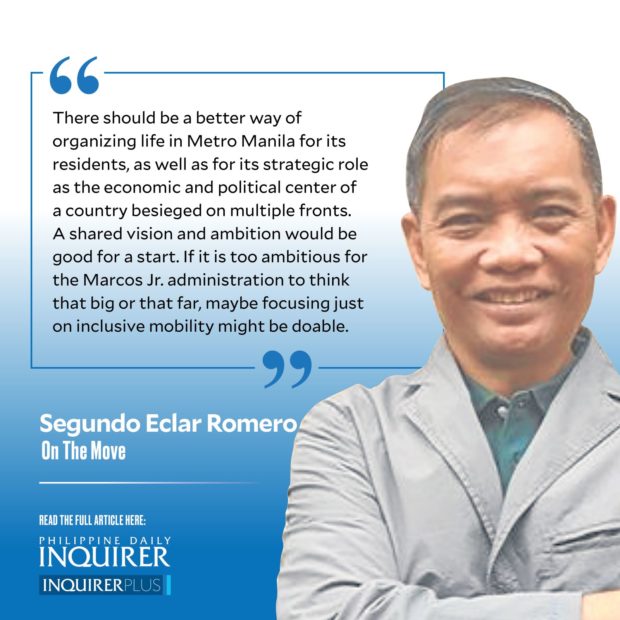Thinking about the Metro: macro or micro?
Now that President Marcos Jr. has visited Indonesia, he may be inspired to open discussion on strategic entry points, like whether the capital of the Philippines needs to be relocated to a less environmentally vulnerable and more developmentally positioned location.
In January, the Indonesian parliament passed a bill to relocate the capital city from Jakarta in Java to the future “Nusuntara” in East Kalimantan in Borneo. This bold move is meant to save Jakarta from sinking further and rebalance the Indonesian economy, half of which is concentrated in Java. On the psychological level, it is also meant to reorient the Indonesian “mindset of development.” Eight principles were enunciated for Nusantara’s development including carbon neutrality and circular economy.
This is not at all a whimsical issue. The Malaysian capital was transferred from Kuala Lumpur to Petaling Jaya in 2003. Myanmar transferred its capital from Yangon to Naypidaw in 2006. Flooding in Metro Manila and surrounding areas in Pampanga and Bulacan are a foreboding signal that gets noticed in passing but without any commensurate seriousness of concern. Transferring the capital may also enable Filipinos to defragment the political capital of the nation.
There should be a better way of organizing life in Metro Manila for its residents, as well as for its strategic role as the economic and political center of a country besieged on multiple fronts. A shared vision and ambition would be good for a start.
If it is too ambitious for the Marcos Jr. administration to think that big or that far, maybe focusing just on inclusive mobility might be doable.
When our Inclusive Mobility Project at the Ateneo School of Government brought several DOTC and MMDA officials and Metro Manila mayors on a tour of the bus rapid transit (BRT) system in Guangzhou in 2015, we all found the system truly impressive. We had technical briefings. We tried out the system from the passenger to the system side, we went to the central control center where the action could be observed from multiple large LCD screens on the walls, and the computer system that made it all tick like clockwork. The Institute for Transport and Development Policy, which provided advice and assistance on the project, said Quezon Avenue or Edsa would be good corridors for the BRT, and the system could be installed in about a year.
No sufficient “political will” for a real BRT has materialized, although there has been a lot of hawing and hewing. Now, we realize that it takes a COVID-19 pandemic to stretch and debilitate the transportation system to gain acceptance of a flimsy carousel BRT imitation.
What I noticed in our Guangzhou visit was the tremendous buy-in the people had for e-bikes, e-trikes, e-quads, and other e-vehicles. They were the main form of transportation complementing the BRT. This “micro-mobility” has become pervasive across China, where some 300 million e-bikes are in use.
Inexpensive Chinese e-bikes have inundated the Philippines for years, and the pandemic has provided the psychological and economic moment for people to embrace them. E-bikes are easy to operate, run at moderate speeds, are silent, produce no exhaust, and only take regular house current to charge them. They are the perfect counterfoil to traffic congestion and the external pressures of energy prices.
The government is promoting the infrastructure for and use of e-vehicles, particularly cars. It is easy to see the adoption of e-bikes, e-trikes, and e-jeepneys will be faster and wider and may serve as the mechanism for the acceptance of e-vehicle technology by the people. Government environmental and energy policies will ensure government support for even e-bikes, e-trikes, and e-quads, if only the appreciation of the policy Land Transportation Office (LTO) does not become overly officious.
The LTO Administrative Order No. 2021-039 addresses e-vehicles and is generally supportive of them, but there are too many classifications and subclassifications of e-vehicles, each one requiring a distinct set of rules and regulations. There are many questionable provisions. LTO must hold real participatory consultative workshops with stakeholders to calibrate the entry of e-vehicles alongside traditional vehicles in our road system. LTO must focus on evidence-based policymaking.
The promotion and use of micro-mobility and inclusive mobility through e-bikes, e-trikes, e-quads, and e-scooters can be the game-changer in enabling people to benefit fully from the metropolitan social and economic network. This is a rare opportunity for LTO to get praise rather than brickbats.
doyromero@gmail.com





















